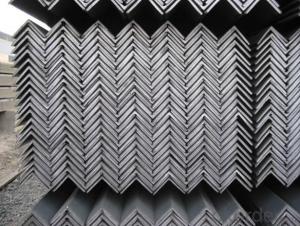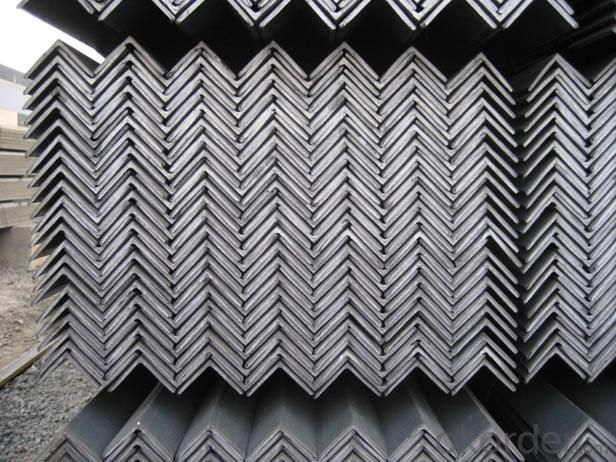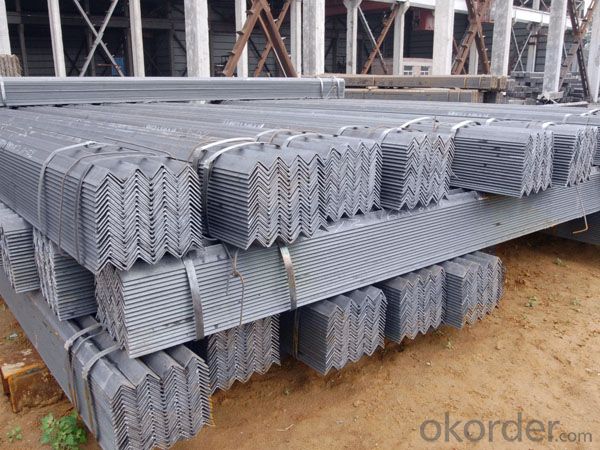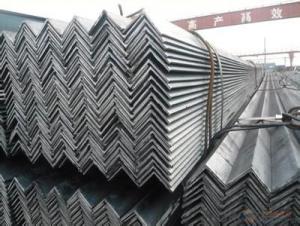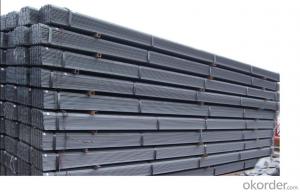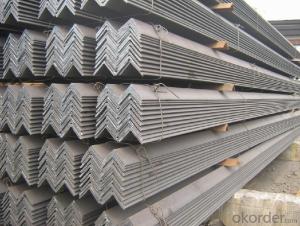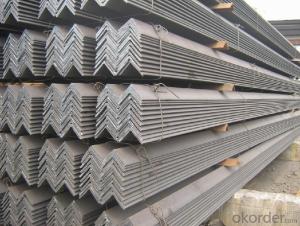Angle Steel Hot Rolled ASTM A36 Or Q235B
- Loading Port:
- Tianjin
- Payment Terms:
- TT OR LC
- Min Order Qty:
- 25 m.t.
- Supply Capability:
- 20000000 m.t./month
OKorder Service Pledge
OKorder Financial Service
You Might Also Like
Product Description:
OKorder is offering high quality Hot Rolled Steel I-Beams at great prices with worldwide shipping. Our supplier is a world-class manufacturer of steel, with our products utilized the world over. OKorder annually supplies products to European, North American and Asian markets. We provide quotations within 24 hours of receiving an inquiry and guarantee competitive prices.
Product Applications:
According to the needs of different structures, Angle can compose to different force support component, and also can be the connections between components. It is widely used in various building structures and engineering structures such as roof beams, bridges, transmission towers, hoisting machinery and transport machinery, ships, industrial furnaces, reaction tower, container frame and warehouse etc
Product Advantages:
OKorder's Steel I-Beams are durable, strong, and resist corrosion.
Main Product Features:
· Premium quality
· Prompt delivery & seaworthy packing (30 days after receiving deposit)
· Corrosion resistance
· Can be recycled and reused
· Mill test certification
· Professional Service
· Competitive pricing
Product Specifications:
Manufacture: Hot rolled
Grade: Q195 – 235
Certificates: ISO, SGS, BV, CIQ
Length: 6m – 12m, as per customer request
Packaging: Export packing, nude packing, bundled
Sizes: 25mm-250mm | ||||||||||
a*t | ||||||||||
25*2.5-4.0 | 70*6.0-9.0 | 130*9.0-15 | ||||||||
30*2.5-6.6 | 75*6.0-9.0 | 140*10-14 | ||||||||
36*3.0-5.0 | 80*5.0-10 | 150*10-20 | ||||||||
38*2.3-6.0 | 90*7.0-10 | 160*10-16 | ||||||||
40*3.0-5.0 | 100*6.0-12 | 175*12-15 | ||||||||
45*4.0-6.0 | 110*8.0-10 | 180*12-18 | ||||||||
50*4.0-6.0 | 120*6.0-15 | 200*14-25 | ||||||||
60*4.0-8.0 | 125*8.0-14 | 250*25 | ||||||||
FAQ:
Q1: Can stainless steel rust?
A1: Stainless does not "rust" as you think of regular steel rusting with a red oxide on the surface that flakes off. If you see red rust it is probably due to some iron particles that have contaminated the surface of the stainless steel and it is these iron particles that are rusting. Look at the source of the rusting and see if you can remove it from the surface.
Q2: How do you package the angle steel when shipping?
A2: All goods are packed in bundles with steel strips and shipped by container or break bulk.
Q3: The products are invoicing on theoritical weight or on actual weight?
A3: According to the customers' request,both of the two is OK.
- Q: Can steel angles be used for manufacturing safety barriers?
- Indeed, safety barriers can be manufactured using steel angles. In construction projects, steel angles are frequently utilized owing to their robustness and longevity. Specifically for safety barriers, they offer a firm framework that can endure impacts and offer protection. By welding or bolting steel angles together, a solid and secure barrier can be created effortlessly. Furthermore, by galvanizing or coating steel angles with anti-corrosive substances, their lifespan and resistance against environmental factors can be enhanced. In summary, steel angles are an exceptional option for manufacturing safety barriers due to their strength, durability, and versatility.
- Q: What is the maximum length of a steel angle that can be transported?
- The transportation of steel angles is subject to various factors, including transportation regulations, the size and capacity of the transport vehicle, and logistical constraints. The maximum length of a steel angle that can be transported is influenced by these factors. Typically, standard transport vehicles such as trucks or trailers can transport steel angles up to approximately 40 feet (12.2 meters). However, the length of cargo that these vehicles can carry might be limited due to road transportation regulations or physical limitations. Specialized transport options, such as flatbed trucks or lowboy trailers, can be utilized to accommodate longer steel angles. These vehicles are specifically designed to carry oversized or heavy loads and may have extended cargo beds or adjustable trailers to accommodate longer lengths. The maximum length of a steel angle that can be transported varies depending on the specific circumstances and available transport options. To determine the most suitable means of transporting steel angles of different lengths, it is advisable to consult with transportation professionals or logistics experts.
- Q: What are the different welding methods used for steel angles?
- There are several different welding methods commonly used for steel angles, including Shielded Metal Arc Welding (SMAW), Gas Metal Arc Welding (GMAW), Flux-Cored Arc Welding (FCAW), and Gas Tungsten Arc Welding (GTAW). Each method has its own advantages and suitability for specific applications, but all are capable of effectively joining steel angles and providing strong, durable welds.
- Q: Can steel angles be used for manufacturing equipment frames?
- Yes, steel angles can be used for manufacturing equipment frames. Steel angles are commonly used in construction and manufacturing due to their strength, durability, and versatility. They provide structural support and stability, making them ideal for designing and constructing equipment frames. Steel angles can be easily welded or bolted together to create a rigid and robust frame structure. Additionally, steel angles can be cut to specific lengths and shapes, allowing for customization and precise assembly. Overall, steel angles are a popular choice for manufacturing equipment frames due to their reliability and cost-effectiveness.
- Q: Are steel angles resistant to chemical exposure?
- Yes, steel angles are generally resistant to chemical exposure. Steel is known for its high strength and durability, making it less susceptible to damage from chemical substances. However, the level of resistance can vary depending on the specific chemical and the type of steel used. In highly corrosive environments or with prolonged exposure to aggressive chemicals, certain types of steel angles may require additional protective coatings or treatments to enhance their resistance. It is always recommended to consult with experts or refer to specific material specifications to ensure the appropriate steel angles are chosen for the intended chemical exposure.
- Q: How are steel angles protected against corrosion?
- There are various techniques available to protect steel angles from corrosion. One commonly used method entails applying a protective coating. This can be accomplished by either painting the steel angles with a paint that resists corrosion or by employing galvanization, which involves immersing the steel angles in molten zinc to create a protective layer on the surface. Another approach to prevent corrosion in steel angles is the application of a corrosion inhibitor. This involves introducing chemicals or compounds to the steel angles that impede or decelerate the corrosion process. Additionally, conducting regular inspections and performing proper maintenance can aid in detecting and addressing any indications of corrosion before they result in significant damage.
- Q: What are the load-bearing capacities of steel angles?
- The load-bearing capacities of steel angles vary depending on various factors such as the size and thickness of the angle, the type of steel used, and the specific application. In general, steel angles are designed to provide structural support and can handle significant loads. The load-bearing capacity of a steel angle is determined by its bending strength and its ability to resist compression and tension forces. These factors are influenced by the material properties of the steel, including its yield strength, tensile strength, and ductility. Steel angles are commonly used in construction and engineering projects for applications such as supporting beams, frames, and structures. The load-bearing capacity of a steel angle is often specified by engineers or designers based on the specific requirements of the project and the anticipated loads. To determine the load-bearing capacity of a steel angle, calculations and structural analysis are typically performed using engineering principles and standards. These calculations consider factors such as the angle's dimensions, support conditions, and the expected loads. It is important to consult relevant engineering codes and standards, such as those provided by organizations like the American Institute of Steel Construction (AISC) or British Standards Institution (BSI), to ensure that the load-bearing capacity of a steel angle meets the necessary requirements for a given application. In summary, the load-bearing capacities of steel angles can vary depending on several factors. Consulting with a structural engineer or referring to appropriate engineering standards is crucial to accurately determine the load-bearing capacity of a specific steel angle in a given application.
- Q: What is the cost of steel angles compared to other structural materials?
- The cost of steel angles compared to other structural materials can vary depending on various factors such as market conditions, availability, and specific requirements. However, in general, steel angles tend to be a cost-effective option for structural applications. Compared to materials like concrete or timber, steel angles are often considered more affordable due to their relatively low production costs. Steel is a widely available material, and its production processes have been optimized over the years, resulting in competitive pricing. Additionally, steel angles offer excellent strength-to-weight ratio, allowing for lighter and more cost-efficient structural designs. When compared to other metals like aluminum or stainless steel, steel angles are typically more cost-effective. While aluminum and stainless steel offer certain advantages in terms of corrosion resistance or aesthetic appeal, they tend to be more expensive due to their production processes and material properties. It is important to note that the exact cost of steel angles can vary depending on the specific dimensions, quality, and quantity required. Prices may also fluctuate based on market conditions, such as changes in raw material costs or global supply and demand dynamics. Therefore, it is recommended to consult with suppliers or industry professionals to get accurate and up-to-date pricing information for steel angles.
- Q: Can steel angles be used in modular building systems?
- Indeed, modular building systems can utilize steel angles. Due to their strength and versatility, steel angles are frequently employed in construction. These angles contribute structural support and stability to the building system. In the realm of modular construction, steel angles serve as framing members, connectors, or reinforcements, depending on the specific design requirements. They can effortlessly be attached and integrated into the modular system, enabling efficient and cost-effective construction. Furthermore, steel angles possess durability and resistance to diverse environmental factors, rendering them suitable for modular buildings that must endure various conditions. All in all, steel angles constitute a dependable and pragmatic option for modular building systems.
- Q: Can steel angles be used for architectural detailing or ornamentation?
- Yes, steel angles can be used for architectural detailing or ornamentation. They are commonly used to add structural support, create unique design elements, and enhance the aesthetic appeal of buildings. Their versatility, strength, and durability make them suitable for various architectural applications.
Send your message to us
Angle Steel Hot Rolled ASTM A36 Or Q235B
- Loading Port:
- Tianjin
- Payment Terms:
- TT OR LC
- Min Order Qty:
- 25 m.t.
- Supply Capability:
- 20000000 m.t./month
OKorder Service Pledge
OKorder Financial Service
Similar products
Hot products
Hot Searches
Related keywords
